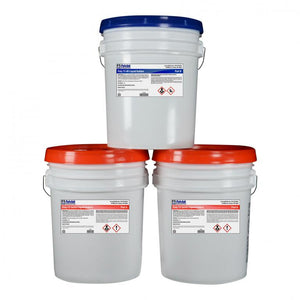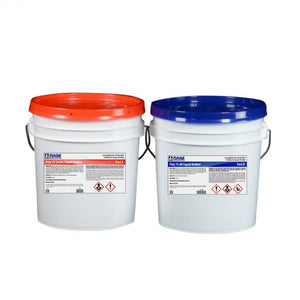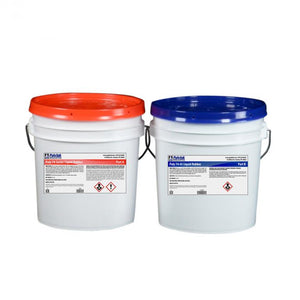Poly 75-80 Mold Rubber - 6 lb

About
Poly 75-80 Mold Rubber - the ultimate solution for high-volume casting operations. With its A~80 hardness and long working time, this firm polyurethane mold rubber provides exceptional abrasion resistance and extends the life of your molds. Whether you're casting concrete countertops, tiles, or other decorative elements, Poly 75-80 Mold Rubber is the ideal choice to achieve professional-grade results every time.
Specs
- For professional use only
- Mix Ratio: 2A:1B
- Pour Time: 45 minutes
- Mixed Viscosity: 5,000 cP
- Specific Volume: 26 cubic inches per pound
Instructions
Model Preparation
Porous models, such as wood, plaster, stone, pottery or masonry must be sealed. Multiple coats of paste wax dried and buffed will seal most surfaces. Potters soap can be used as a sealer for plaster. Lacquer, paint, PVA, and Pol-Ease 2350 Release Agent also work well as sealers for many surfaces. The properly-sealed model should then be coated with a release agent (e.g. Pol-Ease 2300 Release Agent). Alternatively, PolyCoat, a sealer and semi-permanent release agent, can be used on most porous or non-porous models. Porous models must be vented from beneath to prevent trapped air from forming bubbles in the rubber.
Models made or sulfur-containing modeling clay (e.g. Roma Plastilina) should be sealed with shellac. [CAUTION: When shellac is used as the sealer, it must be thoroughly coated with release agent such as Pol-Ease 2300 Release Agent or PolyCoat.
If there is any question about the compatibility between the liquid mold rubber and the prepared model surface, perform a test cure on an identical surface to determine that complete curing and good release are obtained.
Mixing and Curing
Before use, be sure that Parts A and B are at room temperature and that all tools are ready. Surface and air temperatures should be above 60°F during application and for the entire curing period.
Check mix ratio. Weigh Part B into a clean metal or plastic mixing container and then weigh the appropriate amount of Part A into the same container. Mix thoroughly. Hand mixing with a Poly Paddle is best to avoid mixing air into the rubber. While mixing, scrape the sides and bottom several times to ensure thorough mixing. Pour the rubber as soon after mixing as possible for best flow and air bubble release. Vacuum degassing helps to provide bubble-free molds, but is usually not necessary.
Allow rubber to cure at room temperature, 77°F (25°C). Carefully demold after approximately 16 hours. Final cure properties are obtained in about seven days, but molds may be used with care after curing for 24-48 hours. Heat accelerates the cure -- low temperatures slow the cure. Avoid curing in areas where the temperature is below 60°F (15°C).
Both Parts A and B react with atmospheric moisture and, therefore, should be resealed or used up as soon as possible after opening. Before resealing, Poly Purge, a heavier-than-air, dry gas, can be sprayed into open containers to displace moist air and extend storage life. For 55-gallon drums of Parts A and B, affix Drierite cartridges on the small bung during dispensing to protect product from moist air entering the drum.
Softening the Rubber
Add Poly 74/75 Part C Softener to 75-Series products for a lower viscosity mix and a softer cured rubber. When using Part C, cure time is longer and there is some loss of strength in the rubber and increased tendency to shrink after repeated castings. Determine the quantity of Part C required through experimentation.
Accelerating the Cure
Cure time can be shortened with the addition of an Accelerator, such as Poly 74/75 Part X, or by adding heat. By adding 1% Poly 74/75 Part X (by weight of total mix) to Poly 75-80, the working time is reduced to approximately 10 minutes and demolding is possible in as little as 6 hours. Exercise caution when using Part X since the rapid onset of gelling may trap air bubbles on or near the surface of the model. Heat also accelerates the cure. It is recommended not to exceed 140°F (60°C).
Using the Mold
Typically, no release agent is necessary when casting plaster or wax in Poly 75-Series molds. For casting plaster: sponge, dip or spray the mold with Pol-Ease Mold Rinse and then pour plaster on the wet mold to reduce air bubbles in the plaster and aid release. For casting resin, first spray the mold with Pol-Ease 2300 Release Agent or PolyCoat. For casting concrete, use a form release, such as Pol-Ease 2650 or 2601. Avoid solvent-containing releases since they can cause mold distortion (i.e. shrinkage or swelling).
After repeated casting with certain resins, plaster and concrete, molds may shrink slightly since these materials extract oils from the mold. The proper selection of release agent and/or barrier coat can minimize this effect. If shrinkage becomes evident, a light application of Pol-Ease Mold Dressing can help to restore the mold to its original dimensions.
Poly 75-Series molds last many year if stored undistorted on a flat, non-porous surface in a cool, dry location out of direct sunlight. If occasional outdoor use is required, Poly 75-59, 75-65 and 75-80 perform best and UV resistance can be improved by adding Poly UV Additive. Add 0.5% UV Additive to the total mix weight to reduce the characteristic surface degradation caused by sunlight. Never store Poly 75-Series molds outside as UV exposure will eventually degrade the rubber.
Clean Up
Wipe tools clean before the rubber cures. Denatured ethanol is a good cleaning solvent, but is highly flammable and must be handled with caution. Coat work surfaces with wax, Pol-Ease 2300 Release Agent or PolyCoat so cured rubber can be removed.
See More


